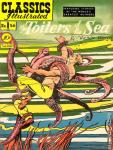Book 9 - The Labour
Chapter 6 - Gilliatt Places The Sloop In Readiness
This rescue of the machinery of the wreck as meditated by Gilliatt was, as we have already said, like the escape of a criminal from a prison--necessitating all the patience and industry recorded of such achievements; industry carried to the point of a miracle, patience only to be compared with a long agony. A certain prisoner named Thomas, at the Mont Saint Michel, found means of secreting the greater part of a wall in his paillasse. Another at Tulle, in 1820, cut away a quantity of lead from the terrace where the prisoners walked for exercise. With what kind of knife? No one would guess. And melted this lead with what fire? None have ever discovered; but it is known that he cast it in a mould made of the crumbs of bread. With this lead and this mould he made a key, and with this key succeeded in opening a lock of which he had never seen anything but the keyhole. Some of this marvellous ingenuity Gilliatt possessed. He had once climbed and descended from the cliff at Boisrosé. He was the Baron Trenck of the wreck, and the Latude of her machinery.
The sea, like a jailor, kept watch over him.
For the rest, mischievous and inclement as the rain had been, he had contrived to derive some benefit from it. He had in part replenished his stock of fresh water; but his thirst was inextinguishable, and he emptied his can as fast as he filled it.
One day--it was on the last day of April or the first of May--all was at length ready for his purpose.
The engine-room was, as it were, enclosed between the eight cables hanging from the tackle-blocks, four on one side, four on the other. The sixteen holes upon the deck and under the keel, through which the cables passed, had been hooped round by sawing. The planking had been sawed, the timber cut with the hatchet, the ironwork with a file, the sheathing with the chisel. The part of the keel immediately under the machinery was cut squarewise, and ready to descend with it while still supporting it. All this frightful swinging mass was held only by one chain, which was itself only kept in position by a filed notch. At this stage, in such a labour and so near its completion, haste is prudence.
The water was low; the moment favourable.
Gilliatt had succeeded in removing the axle of the paddles, the extremities of which might have proved an obstacle and checked the descent. He had contrived to make this heavy portion fast in a vertical position within the engine-room itself.
It was time to bring his work to an end. The workman, as we have said, was not weary, for his will was strong; but his tools were. The forge was by degrees becoming impracticable. The blower had begun to work badly. The little hydraulic fall being of sea-water, saline deposits had encrusted the joints of the apparatus, and prevented its free action.
Gilliatt visited the creek of "The Man Rock," examined the sloop, and assured himself that all was in good condition, particularly the four rings fixed to starboard and to larboard; then he weighed anchor, and worked the heavy barge-shaped craft with the oars till he brought it alongside the two Douvres. The defile between the rocks was wide enough to admit it. There was also depth enough. On the day of his arrival he had satisfied himself that it was possible to push the sloop under the Durande.
The feat, however, was difficult; it required the minute precision of a watchmaker. The operation was all the more delicate from the fact that, for his objects, he was compelled to force it in by the stern, rudder first. It was necessary that the mast and the ringing of the sloop should project beyond the wreck in the direction of the sea.
These embarrassments rendered all Gilliatt's operations awkward. It was not like entering the creek of "The Man," where it was a mere affair of the tiller. It was necessary here to push, drag, row, and take soundings all together. Gilliatt consumed but a quarter of an hour in these manoeuvres; but he was successful.
In fifteen or twenty minutes the sloop was adjusted under the wreck. It was almost wedged in there. By means of his two anchors he moored the boat by head and stern. The strongest of the two was placed so as to be efficient against the strongest wind that blows, which was that from the south-west. Then by the aid of a lever and the capstan, he lowered into the sloop the two cases containing the pieces of the paddle-wheel, the slings of which were all ready. The two cases served as ballast.
Relieved of these encumbrances, he fastened to the hook of the chain of the capstan the sling of the regulating tackle-gear, intending to check the pulleys.
Owing to the peculiar objects of this labour, the defects of the old sloop became useful qualities. It had no deck; her burden therefore would have greater depth, and could rest upon the hold. Her mast was very forward--too far forward indeed for general purposes; her contents therefore would have more room, and the mast standing thus beyond the mass of the wreck, there would be nothing to hinder its disembarkation. It was a mere shell, or case for receiving it; but nothing is more stable than this on the sea.
While engaged in these operations, Gilliatt suddenly perceived that the sea was rising. He looked around to see from what quarter the wind was coming.
